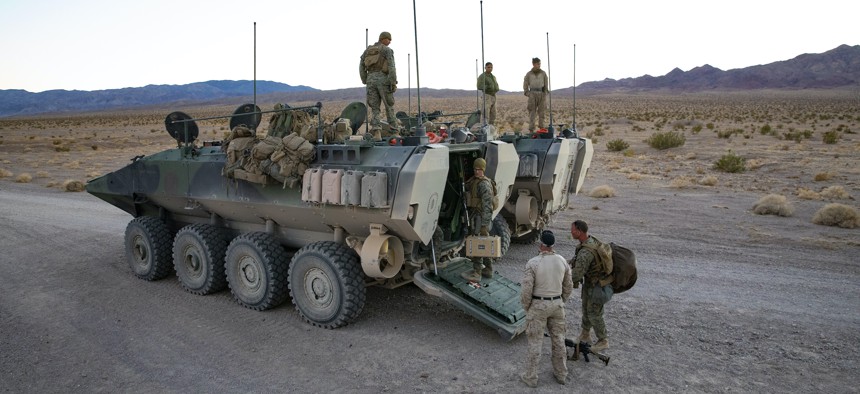
U.S. Marines with Co. D, 3rd Assault Amphibian Battalion and 2nd Battalion, 7th Marine Regiment, 1st Marine Division begin unloading an Amphibious Combat Vehicle (ACV) at the start of Marine Air Ground Task Force Warfighting Exercise (MWX) 2-21 at Marine Corps Air Ground Combat Center, Twentynine Palms, Calif., Feb. 14, 2021. U.S. Marine Corps / Sgt. Courtney G. White
Marine Amphibious Vehicle with Drones Considered For Future Marine Recon Unit
The concept study will be completed in 2023.
The Marine Corps is exploring a variant of the amphibious combat vehicle for its future reconnaissance battalions with an equipment package containing drones and communication systems, and has asked the vehicle’s manufacturer to study how that could be achieved.
BAE Systems is conducting a concept study to explore a command, control, communication, and computers/unmanned aerial systems equipment package on an ACV as an “advanced reconnaissance vehicle” option, said Maj. Joshua Larson, a Marine Corps spokesman.
“After conducting a comprehensive analysis of alternatives for the Advanced Reconnaissance Vehicle (ARV) requirement, the Marine Corps concluded that there was value in exploring both a new design and a Mission Role Variant (MRV) of the Amphibious Combat Vehicle (ACV). As a result, the program executive office, land systems, contracted this concept study to evaluate the utility of an ACV MRV in meeting the requirement to equip future Mobile Reconnaissance Battalions,” Larson wrote in an email.
The ARV, intended to replace the light armored vehicle designed in the early 1980s, has been under consideration and scrutiny for several years, as the Marine Corps transforms according to its Force Design 2030 plan. In the 2020 document, Marine Corps Commandant Gen. David Berger questioned whether the service should procure another reconnaissance vehicle, but a year later he said they may need it as they re-evaluate how to use their light armored reconnaissance units, a Congressional Research Service report said.
The Marine Corps’ light armored reconnaissance battalions currently use the LAVs. The service is considering modernizing these units, as part of Force Design 2030, to become “mobile reconnaissance battalions.” They would use the ACV being studied, according to Larson.
The future units “will be equipped with a combination of multi-domain, manned, and unmanned systems, and be capable of conducting expeditionary ground reconnaissance and contributing to the naval expeditionary force's reconnaissance and counter-reconnaissance missions,” he said.
The ACV moves Marines from ships to the shore and then onward from there. This vehicle would be used in Expeditionary Advanced Base Operations, a concept that has Marines working within close range of an adversary.
BAE Systems has two ACV variants in full-rate production: one for personnel and the other for command and control. The defense company is also developing two other variants: one for recovery and repair missions, and the other with a 30mm cannon.
The ACV with the C4/UAS mission payload will “feature a state-of-the-art battle management system and advanced sensing capabilities,” BAE Systems said in a press release April 7.
“This C4/UAS variant will provide the transformational technology Marines need to observe their surroundings, collect and integrate information, and sense new targets over the horizon,” the defense company said.
According to Larson, the mission package in the vehicle BAE Systems is studying includes: a medium tactical UAS with its controls and C4 components; a “network-on-the-move system,” meaning satellite communications; a sensor and “electronic warfare suite” on a retractable vehicle mast; and a UAS that is tethered, potentially for power or data reasons.
BAE Systems will develop a concept design and use a “mobile systems integration lab” to simulate the vehicle and test its technology, Larson said. The study is to be completed by the third quarter of 2023. While the Marine Corps analyzes its light armored reconnaissance battalions as part of Force Design 2030, Larson said the service is already preparing to modernize it and its equipment for “multi-domain, mobile reconnaissance,” including with this study.
“The output of this concept study and other ARV prototyping work will inform a planned service-level decision on the organization and equipping of future mobile reconnaissance units.”




